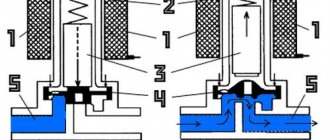- Why the washing machine does not drain water: main reasons
- The washing machine does not drain water: we determine the reasons by the signs
- The unit does not drain water: do-it-yourself washing machine repair
- The washing machine does not drain water: what to do, reasons for breakdowns of units from different manufacturers
- How to drain water yourself if the drain is not working
- How to prevent filter blockages: editorial recommendations
- Summarize
Why the washing machine does not drain water: main reasons
Often the user himself is to blame for the fact that the water does not drain from the washing machine, and the equipment has nothing to do with it. For example, an incorrectly selected program in which the machine does not drain the water so that the laundry does not wrinkle. Before you suspect a breakdown, you should start small and re-read the instructions. If an incorrectly set program is confirmed, you should set the correct one and restart the washing cycle. There are often cases of kinks in the drain hose - this option is also worth checking. The hose, siphon or sewer system itself may be clogged.
Good to know!
If the siphon or sewer is clogged, water will not flow upward or out - as such, there is no pressure in the drain. After all, water is pumped not by a pump, but by a pump that is unable to create high pressure.
If the above problems are not confirmed, then the problem is in the machine itself. The automatic machine may not drain water due to:
- the filter installed on the drain is clogged;
- pump failure;
- failure of the programmer, control module, program failure;
- failure of the water level sensor (pressostat).
Let's try to understand how we can determine the cause of the failure.
Call the master
If you can’t diagnose LG SMA yourself, you can always call a specialist for repairs. It is advisable to contact companies that have been on the market for providing services for several months and have a decent reputation.
It is not difficult to find such a company on the Internet by additionally entering the name of your city in the search. You can contact the company by phone listed on the website or by leaving your contact information for the manager to contact. After eliminating the malfunction, the master gives a guarantee for the work performed.
The average cost of services in Moscow is:
- repair of damaged wiring – from 2,000 rubles;
- repair of the control module – from 2,600 rubles;
- replacement of the drain pump – from 2,100 rubles;
- blockage in the drainage tract - about 1,500 rubles.
The cost of work may vary by region and even vary widely within the same city.
The washing machine does not drain water: we determine the reasons by the signs
In the absence of a drain, two options for the “behavior” of the unit can be observed - the water does not drain completely or does not drain at all, but the machine hums, as if draining. Let's figure out what becomes the root cause of this.
The water drains, but not completely: options for correcting the situation
There are several reasons for this malfunction. Let's try to list them:
- The filter element is clogged . Often there are coins and scraps of paper left in your pockets, which fall out when washed. Small pieces of fabric may also get caught in the filter. This problem can be solved simply - unscrew the filter plug (usually at the bottom right) and clean the element.
- The drain hose is clogged. Disconnect the hose, clean, rinse, and reinstall.
- Threads and hair are wound around the impeller or pump shaft . If this happens, you should remove the pump and remove foreign objects. It is also possible that the impeller breaks down or the pump motor fails - in this case, the unit will have to be replaced, however, before this, you should drain the water from the machine yourself.
Important!
When unscrewing the cap, be prepared for water to flow. Have a drain pan and rags ready to wipe the floor.
We will talk about how to do this at the end of our article, but now we will deal with the second malfunction.
The washing machine does not drain water and is humming: what to do
The reasons are the same as in the previous version, however, there is one more, for which it is not the equipment that is to blame, but the person - overload. If the unit is designed for 3 kg, then you should not load all 5 into it... the automation simply will not allow the engine to spin, while it will heat up itself and may even burn out. Another reason that the washing machine does not drain water and hums may be a failure of the control module, a firmware failure, or burnout of individual contacts. If a home technician does not have experience working with microcircuits, there is no point in getting into the “brains” of the unit.
What to do
Before repairing your washing machine, prepare a water container and a rag.
It is necessary to solve the problem with drainage based on the cause of the breakdown.
In case of a minor software glitch, the following steps should help:
- Stop the selected operating mode of the machine using the buttons.
- Unplug the machine cord from the outlet.
- After 2 minutes, turn on the machine again and run the “Rinse and Spin” program.
If the filter is clogged, the following steps should be taken:
- Empty the water from the drum yourself.
- Unscrew the filter to check.
- If a blockage is detected, thoroughly clean it of debris and put it back.
- Start the spin program.
The unit does not drain water: do-it-yourself washing machine repair
Some washing machine malfunctions can be corrected yourself if you follow certain rules. Let's try to figure out the main problems that the owner of a washing machine may encounter. Among them:
- failure of the pressure switch (water level sensor);
- electrical wiring faults;
- electronics failure;
- pump failure;
- clogged filter or pump impeller;
What to do if the pressure switch fails
First, you need to make sure that it is the pressure switch that has failed. Let's figure out how to check it. To do this, first turn off the power to the washing machine (SM), unscrew the 2 screws from the back that hold the top cover. We remove the top and see a rounded part on the wall to which the hose fits, and several wires. This is a pressure switch.
Now loosen the clamp and remove the hose from the fitting. Instead, install a piece of hose of the same diameter, clamp the clamp and blow into it. You should clearly hear one or three clicks, indicating that the pressure switch has activated. If this does not happen, you will have to replace it.
Electronics failure: is it possible to solve the problem without calling a specialist?
This problem often occurs on SMs with a large number of functions. The set program, without completing the cycle, jumps to another, as a result of which the SM stops. Don't panic, you can solve this problem yourself. First, turn off the unit from the button and wait 15-20 seconds, then turn it on and load the desired program again. If this does not help, and the water remains in the drum again, turn off the machine completely (from the button and from the network) and wait 5-10 minutes. Then we turn it on again, load the program and wait. If the problem recurs, we can say with confidence that the program failure has nothing to do with it. Just in case, if the SM has a self-diagnosis mode, it should be turned on. By displaying an error code on the display, it will tell you why the washing machine does not drain water. All error codes are available in the technical data sheet of the unit.
Damaged electrical wiring: how to identify it yourself
To identify this malfunction, we need a multimeter. We find the pump and unhook the wires from it. Next, we perform the same procedure with the terminals on the board. We set the multimeter to sound resistance - it will be easier, you don’t need to look at the display. We call each wire individually and replace it if necessary.
Pump failure: is it possible to do without replacement?
So, the washing machine does not drain water due to the pump failure. Unfortunately, if the impeller breaks or the pump motor fails, you will not be able to do without a replacement. It’s another matter if threads and hair are wound around the shaft. In this case, we dismantle the pump, first removing the filter, and clean the shaft of foreign objects. Their presence can be determined as follows. We take out the filter, you can see the impeller inside. Let's try to check it out. It should rotate easily, perhaps with slight jerking - this is normal. If the rotation is tight, it means there are foreign objects on the shaft. If it does not rotate at all, it means that the engine is jammed, and such a unit cannot be repaired. You'll have to buy a new one.
Helpful information!
It is better to go to the store with an old pump. It is not a fact that there will be a part for your model in stock. In this case, you can choose an analogue from another model - many pumps are the same, even for different src=”https://cdn1.gadgets-reviews.com/images/images_2019/08/stiralnaya-mashinka-ne-slivaet-vodu_13.jpg” class=”aligncenter” width=”560″ height=”410″[/img]
Clogged filter or pump impeller: what actions should be taken
A clogged filter is not a problem at all. To clean it, you need to unscrew the plug (it is located at the bottom of the CM and can be hidden by a decorative hatch), pull out the filter, remove large debris from it and rinse it. But with threads wound around the impeller it is a little more complicated. Here you will have to remove the pump, only after this will you be able to clean the impeller of hair and threads. However, even novice home craftsmen can do this work. The main thing here is attentiveness and accuracy.
The drain in the washing machine does not work for other reasons
If after all the work done there are no changes, and the water still does not drain, most likely the problem is in the electronic module. Here you will not be able to carry out repairs yourself if you do not have the appropriate education. In this case, the only solution is to call a technician to your home or take the SM to a service center.
Helpful information!
Transporting an automatic washing machine to a service center is a better decision than searching for a repairman through advertisements. It may happen that a person comes to your home who knows less than you about SM, and learned how to repair them from videos on YouTube.
Checking the pipe
To check the pipe connecting the washing machine tank to the pump, you need to dismantle it. To do this, you need to unscrew the bolts securing the drain assembly, remove the fixing clamp and remove the pipe. The water from the pipe must be drained into a previously prepared container, and the pipe itself must be checked to see if it is clogged with any debris. The blockage must be removed and the entire structure must be reassembled in reverse order.
If the car owner is not sure that he can independently find this part and carefully dismantle it, then it is better to seek help from a professional technician. If the cause of the malfunction is not in the pipe, then a specialist will be able to determine what needs to be done to get the machine working again.
The washing machine does not drain water: what to do, reasons for breakdowns of units from different manufacturers
As you know, each manufacturer has its own characteristics. Now let’s look at the most popular brands and understand why different machines do not wring out or drain the water.
LG washing machine does not drain water: possible causes and “treatment”
The peculiarity of LG brand SM is that debris rarely gets into the drain hose or remains in the pipes. It all settles on the filter, and that’s very good. If you have such a “helper”, then the only thing you need to do is not to be lazy and clean the filter more often. Ideally, this is done after every wash.
BOSH washing machine does not drain water: nuances of models of this brand
There is a rather interesting nuance here that is often overlooked. Lint and debris accumulate in the plug. Not in the filter, but in the lid. This is quite disturbing. But the sore point of these SMs is the pump. It most often fails. Therefore, there is no need to guess what to do if the washing machine does not drain the water. If the pipes and hoses are clean, it’s a pump. BOSH electronics are very reliable and rarely fail.
Indesit washing machine does not drain water: brand features, reasons and solutions
This brand has no significant differences from other brands, and therefore the actions are still the same. However, the Indesit brand has an interesting problem. After pumping water, it immediately begins to drain, i.e. The washing machine drains water constantly. There may be several reasons for this:
- incorrect connection to the sewer;
- water inlet valve failure;
- Pressostat malfunction.
If the drain hose from the washing machine is connected to a siphon, then it is raised above the floor to a certain height, and the first point can be lowered. If it goes directly along the floor, you can try to pick it up and throw it in the sink. If the “gain-drain” cycle continues, move on.
Water inlet valve: if it does not close in time, an overflow occurs, the pressure switch gives a command about an emergency situation, and the water is drained. It is better to entrust the problem with the valve to professionals. Pressostat: we have already written about checking it, but here the situation may be more complicated, and the pressure switch requires adjustment. This is also the case when it is better to trust the specialists.
Samsung washing machine does not drain water: what are the pitfalls of this brand
What should you do first if your Samsung washing machine does not drain water? In addition to all the faults listed above, SM Samsung has a tricky mode. When set to “delicate wash”, the water is not drained so as not to damage the items. Often it is this reason that baffles the housewife, especially if the SM was purchased recently. Otherwise, everything is similar to previous brands.
Replacing the pump
The pump impeller is located immediately behind the filter. When the filter is removed, it can be seen in the opened hole. After draining the water, you can try to turn the impeller by hand. If it turns only after applying quite serious efforts, then this means that some foreign object is interfering with it, which should be removed.
If no foreign objects could be found and the impeller does not rotate, then the cause of the malfunction lies in the drain pump. You can try to replace it, but if you lack experience, it is better not to risk it and entrust this task to a specialist from the service center.
Incorrect operation of the drain pump may occur due to equipment wear or defects during production. But you should know that the pump does not fail overnight. At first, strange sounds will be observed when it is turned on and malfunctions.
If you still decide to replace the pump yourself, then you need to purchase it. A branded pump will fully match the brand and series of your washing machine, but its cost can be quite high. There are universal models of drain pumps that are suitable for several machines at the same time. They are practically not inferior to branded ones in quality, but their price is more attractive.
To replace the pump, you must:
- dismantle the machine drainage unit;
- remove the drain pump;
- disconnect the wires;
- install a new pump in place of the old one;
- attach wires to it;
- install the drainage unit in its place.
How to drain water yourself if the drain is not working
It's pretty simple. Stock up on a container with low sides and plenty of dry rags. The water drains through the filter plug. To do this, place the container and open the cap. As the container fills, close the cap, pour out the water and repeat the procedure. So until the SM is completely empty.
How to prevent filter blockages: editorial recommendations
There are only two simple rules here:
- Clean and rinse the filter as often as possible.
- Before throwing things into the wash, check your pockets and take out everything that is there. Buttons, coins, pieces of rags, papers - these should not get into the pump.
As you can see, the rules are simple and quite easy to follow.











